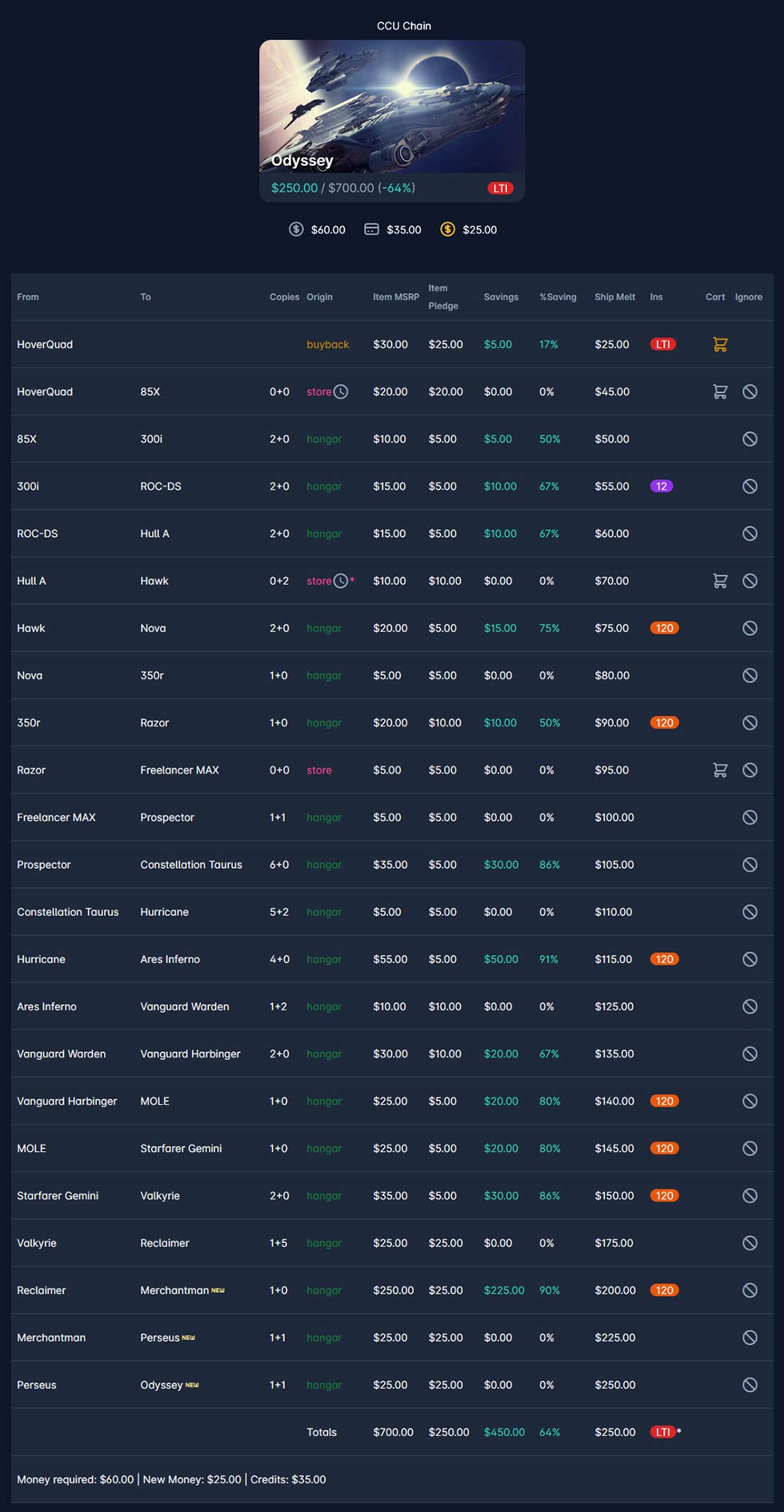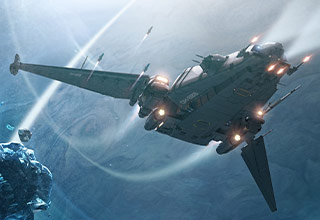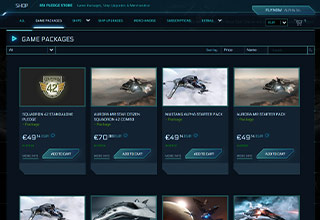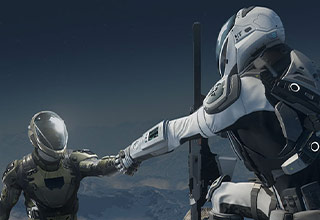In a CCU Chain, the most important element is obviously its body, which is made up of one or more links that are none other than upgrades and warbond upgrades. As explained in the introduction, the aim of the CCU Chain is to accumulate several warbond upgrades in order to accumulate discounts.
Consequently, a link must comply as closely as possible with the following rules:
Every link consists of an entry point and an exit point. The entry point must be easily accessible and preferably "evolution-proof", while the exit point can be "evolutive ".
Every link should, if possible, offer a discount, as this is the aim, otherwise the chain loses all interest...
Every link must cost as little as possible, as warbond will involve real money, and the aim here is to spend as little real money as possible.
What is an "evolutive" link?
A link is "evolutive" if it is built on the basis of a vessel whose value can change at any time. So any link that involves a ship not yet in play is generally evolutionary, since when the ship comes into play, it will probably increase in value.
Hence the importance of placing such a vessel in a chain link...
If an evolving ship is placed at the end of a link, any increase will be good to take as long as the value of the ship involved does not exceed that of the targeted ship.
Example: Once again, let's take the case of the Odyssez at $250 HT.
This vessel's chain includes an evolutionary link that has had a major impact on the result obtained. This was a CCU warbon Reclaimer to Merchantman purchased for $15 ex VAT when the BMM had just passed the $350 mark. At the time, this CCU warbond gave a discount of $25 ex VAT on the entire chain, and over time the BMM gained in value.
During the IAE 2952, the BMM reached the $650 HT mark while remaining below the value of the Odyssey (my target), which meant that this CCU warbond allowed me a discount of $225 on the Odyssey, i.e. almost 36% of the value of the targeted vessel in a single link that initially cost $15.
Beware of the critical aspect of seeing the value of a ship involved in your chain exceed that of the target ship.
It's best to finalise the ship before this happens. If you can't, make sure you have a 'go back' upgrade in your hangar and that this upgrade doesn't break your chain.
If we take the previous example of the BMM compared with the Odyssey, at AEI 2952 there is only $50 between the two ships, and it is highly likely that the next upgrade will be at least $50, so the two ships will arrive at equal value. If you don't want to find yourself unable to upgrade the BMM to the Odyssey because of a zero (or negative) CCU, it becomes crucial to either apply the chain before the new increase, or to anticipate and have in reserve an upgrade of the BMM to the Odyssey at $50 which will remain functional whatever the future value of the ships and as long as you keep it in your hangar (you mustn't melt it). In my case, I preferred to finalise my chain by applying all the CCUs up to the Odyssey.
Of course, this is an exceptional case, but opportunities like this can regularly arise because all the ships that are still in the concept phase give you the chance to create new evolutionary links.
What's more, in the case of such a link, there's no requirement to use a warbond CCU. For example, a simple standard CCU from the Cutlass Red to the Vulture, paid for at $5 ex VAT with store credit during IAE 2952, was transformed into an evolutionary link once Alpha 3.18 was released and the Vulture came into play, which then increased.
Let's now look at the opposite case of the evolutionary vessel placed at the start of the chain, as it will lose all its interest if the vessel increases in value.
As a general rule, it is preferable to only take ships that are already available in-game, as they are less likely to increase in price (although this can happen), and if possible, ships that are easy to access.
Example: Suppose that during an IAE, a CCU warbond comes to offer you a $10 discount on the Prospector.
In such a situation, you have several options at $5 ex VAT:
- Ballista to Prospector
- Hornet Tracker to Prospector
- Hull B to Prospector
- Vulture to Prospector
The future has shown us that the Vulture towards the Prospector was the worst choice of all, because the latter increased in value when it was put into play and is now worth less than the Prospector. This is the kind of thing you need to anticipate and avoid. What's more, even though this is no longer the case, the Vulture was on limited sale for the year, so you didn't have the chance to complete your chain once the IAE was over if you hadn't anticipated this by taking a junction CCU.
The Hull B to Prospector is no good either, here again the ship is on occasional sale and once again we are dealing with a concept ship, you know that at some point the ship will see its value change and kill your upgrade. Why take such a risk?
The Ballista or Hornet Tracker to Prospector are already safer because the Ballista and Hornet are in play and it's highly unlikely that their price will ever change, especially as both are available year-round.
The availability of an entry-level ship is important!
In addition to the scalability of a ship over time, it is also important to ensure that you can complete your chain at any time and not be dependent on having to wait for the next IAE, Invictus or any other event offering sales of ships that are not available all year round.
For example, at IAE 2952 we had a warbond upgrade to the F7C-M Super Hornet for a discount of $15. This CCU only offers two options at $10:
- Prospector to F7C-M Super Hornet
- Razor EX to F7C-M Super Hornet
Both the Prospector and the Razor EX are in play, so in theory there's no risk of their prices changing, but the difference between them is their availability: the Prospector is available all year round, whereas the Razor EX is rarely offered for sale. So if you have to make a choice, it's best to go for the Prospector.
Of course, in the context of IAE 2952, as long as Misc day hadn't yet arrived when the CCU-warbond to the F7C-M Super Hornet was proposed, there was always the doubt that "maybe there's going to be a warbond on the Razor EX". As a result, you're faced with a choice between playing it safe with the Prospector, or taking a gamble with the Razor Ex. Or else, you take both, but be careful with your budget - something you should always keep in mind as soon as you start acquiring multiple choices.
The availability of the ship at the end of the chain is irrelevant!
On the other hand, you don't have to worry about whether a ship is available all year round or not when it comes off the chain, as the upgrade tool gives you all the existing ships when you build your upgrade.
The accordion effect
The accordion effect is a rather special case where, following a change in the value of a ship, a CCU loses power, but in the end this doesn't matter because the CCU with which it is linked recovers what the other has lost. This is a fairly rare situation, and means that the rule about not having an upgradeable ship at the start of the chain has not been respected.




